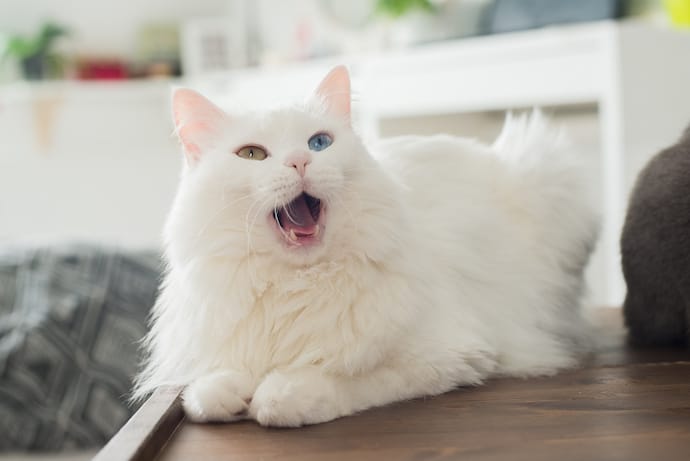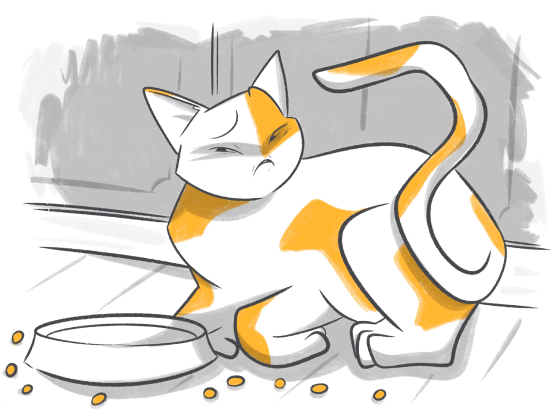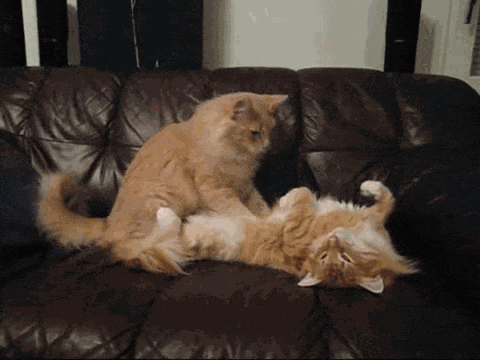Every "crazy cat lady" out there will tell you that cats are great conversationalists. And it's completely true: cats have a lot to tell you.
Fortunately, understanding how to communicate with your cat is as easy as learning to read cat body language and translate those adorable meows to words.
Stop Googling - Ask a Real Vet
If you’re a bit rusty when it comes to feline communication, this article will help you finally understand what your kitty is trying to tell you:
- Cat Body Language: Ears and Eyes
- Tell-Tail Signs
- Understanding the Body Language of Your Cat
- Speaking Feline: Cat Vocalizations Explained
- How to Communicate with Your Cats
Cat Body Language: Ears and Eyes
When you’ve mastered the subtle art of distinguishing between the different sounds cats make, it’s time to start understanding cat body language. Learning how to make sense of their movements and gestures will make you a true feline whisperer!
When it comes to deciphering cat body language, it’s not all written on their face. In reality, their faces and facial gestures can reveal just a small fraction of their thoughts.
Here are some examples that can help you better understand cat behavior:
Ears
- Slightly forward: Your kitty is feeling curious and playful, so this gesture can often be spotted while they’re checking out a new toy!
- Straight and upright: Something got your cat’s attention, that’s for sure. Cats have super-powered hearing, and when their ears are straight and up, it means something alerted them.
- Pinned back, flat: You have a very, VERY angry kitty on your hands. This gesture is often accompanied by hissing or growling, and it indicates that your cat is either furious (probably at you) or frightened.
Eyes
- Slowly blinking: Slow blinks are the air kisses of the feline world! If you notice your cat slowly blinking at you, there is no need to be perplexed by this strange cat behavior. It simply means that your cat adores you.
- Dilated pupils: Someone is definitely excited! Whether they’re playing or preparing to viciously attack a toy, dilated pupils are a sure sign of feline excitement. However, if combined with defensive or aggressive gestures or sounds, big, wide pupils can mean your cat is scared.
- Slit (constricted) pupils: A look of annoyance, often noticed in the absence of treats or your cat’s favorite kibble in the bowl. You’re definitely not living up to your kitty’s standards!
Tell-Tail Signs
Cats communicate with their whole body (more on that below), but one body part, in particular, tells it all. You’ve guessed it—the tail! Unlike dogs, whose tail wagging simply means joy, when it comes to cat tail language, the matters are much more complex. (We would expect no less from our feline overlords.)
If you have wondered why cats wag their tails or if cats’ control over their tails tells us something, this comprehensive chart will clear any confusion!
Cat wagging tail
Oh-oh. Your kitty is seriously frustrated with you. If you’re wondering why cats flick their tail when you’re trying to pet them, watch out, because otherwise it might take a few scratches to clear things up.
Cat tail twitching
A milder version of wagging, twitching often means that the cat is only flicking the tip of their tail and it indicates a playful mood. If you see a cat chasing its tail, you can be sure that they started twitching it first!
Puffed up tail
Although it looks hilarious and adorable at the same time, a fluffy, puffed up tail is not one of the positive cat tail signs. It means that your kitty is terrified of something, or, if accompanied by hissing, preparing to attack.
Tucked away
If your cat has their tail between their legs, it’s a sign of anxiety and submission. When something makes your cat nervous, like a new environment or a new family member, they’ll tuck away their tail.
Curved tail
When a cat curves their tail in a shape similar to question mark, it means that they’re ready to explore and play! If you’ve been waiting to introduce them to that new toy you got them, now is the perfect time.
Embracing tail
A cat that curves its tail all around them, creating a cute, fluffy embrace is a happy, satisfied one. Cats can even embrace other cats with their tails, giving them a warm, feline hug.
Understanding the Body Language of Your Cat
When I say understanding a cat’s body language, I mean what they’re saying when they use their WHOLE BODY to communicate. Because it’s not enough for kitties to tell us what they think by using their tails, ears or a variety of sounds. They need another way of communicating what’s on their feline minds.
This is cat behavior explained through their (whole) body language.
Lying on their back, belly exposed
This means your cat completely trusts you and feels comfortable enough to reveal their most vulnerable area to you. On the other hand, there is a 99% percent chance you’ll get your hand scratched if you dare go for a belly rub. I know, it’s a trap that few people can resist.
Special combination: If your cat growls while lying on their back, they’re agitated and ready to strike.
Arched back
Get ready for cuddles! If a cat gets near you and arches their back, they’re trying to tell you to pet them (scratches behind the ear are also welcomed).
Special combination Arched back in combination with bristled hair (think Halloween classics) means your cat is frightened or angry.
Rubbing against you
Even though most people think this means their kitty is feeling affectionate, the real reason for rubbing is a bit more complex. Cats rub against things (or people) to mark their territory. This is especially true when they rub their cheeks at something, because of the glands located there that release special (territorial) pheromones. But hey, at least your kitty is claiming you!
Kneading
Every time a cat “makes biscuits”, it’s a remnant of their kittenhood memories. Cats knead only special people, and only when they’re particularly happy and content. Be proud if a kitty wants to knead on your lap!
Butt wiggling
Nope, your kitty is probably not the biggest fan of an artist that has the word Dogg in their name. The funny and cute butt wiggling is a precursor to pouncing and it’s one of the many cat body language signs connected to stalking prey.
The curled up cat
This is the most common sleeping position in cats. It means that your cat feels calm and safe. Sleeping this way cats minimize their heat loss. However, if you have not noticed that your cat is sleeping too much during the day curled up, you need to pay attention and check with your vet.
Licking you
If you deserved a special grooming session from your cat - it means a lot. Now you're a special "cat". Cats show great affection when they start licking your skin, hair, earlobes or even nibbling on your clothes, considering you as an important part of the family group. They do it in the same way as you show affection to your cat by petting it.
BrightSide prepared three essential tips that will help you communicate with cats better:
Speaking Feline: Cat Vocalizations Explained
From different variations of meow to a variety of weird sounds, cats definitely don’t hesitate to vocalize their demands or opinions. The problem is, understanding cats is not always easy. If you can’t tell the difference between an irritated meow and a playful one, you’re bound to get scratched!

Here are the most common types of meows… Conveniently translated to human, of course.
- Short, high-pitched meow: “Hi, human! How’s it going?”
- A number of short meows at once: “I’m so happy you’re back! Instead of jumping at you like a silly dog, I’ll just tell you I’ve missed you!
- Soft, pleading meows: “I’m hungry, so I’ll be a super-cute suck up. How can you resist feeding me right away?”
- Drawn out or low meow: “The service at this place sucks. You’re really getting on my nerves, human servant.”
However, recognizing the meaning of a meow is just part of learning cat language. Felines make a number of different sounds when trying to communicate, such as:
Trilling
A sound somewhere in between a meow and a purr. It’s often used as a greeting or a way to get your attention by being completely adorable. It doesn’t get cuter than that!
Chirping
Your kitty is proving their hunting skills by trying to attract unassuming wildlife. Try not to scare off their prey by gushing over them and giggling at the cute sound they make.
Yowling
Sounding like a cross between yodel and howling, this particular feline sound is one of the most irritating. Although yowling is a mating call that’s usually reserved for cats in heat, spayed and neutered cats can yowl too.
Hissing and growling
Reserved for situations when they’re frightened or furious, the hiss and growl routine is never a good sign. If you don’t suspect that your cat is in pain or injured, this probably means it’s best to just stay away.
If your cat is constantly hissing and growling, it's possible that they are in a lot of pain or perhaps they have an injury that needs immediate medical care. And while we can prevent some accidents and injuries from happening to our pet, we never know when a pet emergency may occur. Because of this, it is wise to invest in services such as Petcube’s Pet Emergency Fund to be prepared in case of emergency situations.
Pet Emergency Fund is an insurance alternative that welcomes pets regardless of age, breed, and medical history. It has a coverage of $3000 per year for upto 6 pets. A subscription also gives you access to a 24/7 online vet service where you can consult with certified vets anytime and anywhere. With Pet Emergency Fund, you are given the support and peace of mind that you need to be able to focus on taking care of your pet without worrying about the vet bills.
As an exclusive discount for our blog readers, we are offering 27% off on subscriptions if you follow this link.
Soundless meowing
A meow so silent you barely hear can sometimes be a sign of exhaustion or hunger and dehydration. Of course, if you have a healthy, content kitty, this might just be their way to play on your heartstrings. (My cats do this all the time. It works.)
Purring
What does it mean when a cat purrs? Is it a sign that your cat loves you? Rest assured. The velvety, vibrating sound of the purr is one of the best sounds you can hear from your furball! A cat’s emotions can be a mystery, but hearing a purr is a definite sign of your kitty’s happiness and affection.
However, in some cases, abnormal purring can be a sign your cat is in pain, so if you notice their purring is out of the ordinary, take them to a vet for a checkup.
How To Communicate With Your Cats
Understanding your cat is amazing, but how can you get them to understand you? Dogs respond to commands and your voice, but cats are not that interested in what you have to say. However, this does not mean that your cat doesn’t understand you.
Scientists have come to a conclusion that felines are (at least) equally capable of interpreting human language as dogs. The fact that they’re acting like they don’t understand us, well, that’s another issue.
Even if your kitty pretends not to hear you, it doesn’t mean you shouldn’t communicate with them. A soothing, reassuring voice can help encourage a shy, frightful cat or motivate them to cuddle with you. In the same manner, a firm, sharp voice can help you teach your cat about unwanted behaviors, such as batting or scratching the furniture. (In theory, of course, in reality cats will do as they please).
When you’re away at work, use a pet camera to communicate with your cat. Even though they might not show it, they are missing you. And the sound of your voice followed with a treat from Petcube Bites pet camera is bound to make their furry heart melt a little.
Was this article helpful?
Help us make our articles even better










